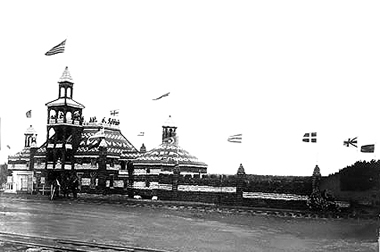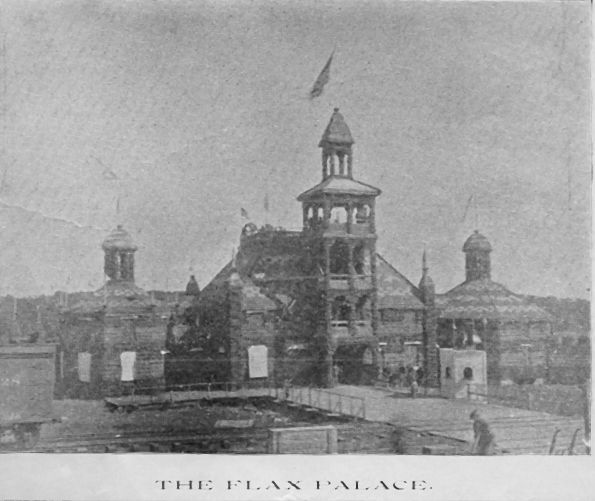The Flax Palace in Forest City
compiled by S. Ferrall
Flax had been introduced to Winnebago county with
great financial success by settlers from Illinois and
soon the area surrounding Forest City was the leading
flax producing region west of the Mississippi river.
The principal purpose of the Flax Palace was to
advertise the flax grown in Winnebago county and to
bring visitors, investors and income to the area. This
crop was favored at the time, as one growing best on
virgin soil and for preparing the ground for other
crops. The first Flax Palace was built at the county
fairgrounds in Forest City, and opened in 1890.
The 1892 biography of Jasper Thompson states:
"..it was he who conceived the idea and caused
to be erected the flax palace at Forest City."
In 1890, Mr. Thompson wrote this news release about
the Flax Palace ....
"The north central and northwestern parts
of Iowa, and especially Winnebago and Hancock
counties, have been for years known to be the
most productive section of country on earth, and
the soil particularly well adapted to the
production of all the small grains, corn, wheat,
oats, rye, barley and flax, the latter being a
crop that can be planted from March to July and
harvested from July to October, producing quicker
returns to the laborer than any other known
agricultural production.
Forest City, thus located as it is in the very
center of the greatest flax producing section of
country in the world, has determined to better
make known its vast agricultural resources in the
production of this particular crop, [and] has
arranged in connection with the county
agricultural fair, to build, decorate and exhibit
to the public a magnificent flax palace, which
shall, in beauty of decoration and nicety of
design, out vie even its elaborate
contemporaries, though it should fail in
producing a structure equal in size.
The promoters of this scheme are fully aware that
flax is not the principal crop raised in this
section of country, nor is the building of a flax
palace intended to over shadow the fact that here
we raise as fine crops of corn, oats, wheat, rye,
barley and potatoes as are raised in any country
in the same latitude; but for beauty of color
flax straw surpasses almost every other of the
straw producing grains.
The flax palace therefore will not be restricted
to flax straw and flax seed decorations alone,
but every grain and grass raised in this section
of country will be employed in its decoration.
The structure will be of artistic design and
ample capacity, and in its architecture various
turrets, towers, balconies and lookouts will be
employed, all gorgeously thatched and decorated
with the various colored growth of flax and other
grains and grasses, pressed leaves, ferns and
flowers; and when fully completed will be "a
thing of beauty" indeed.
The interior of the structure will be divided
into booths for the display of the various arts
and sciences, and for agricultural, mechanical
and other displays, and will all be beautifully
decorated with landscapes and other artistic
designs.
During the entire time the exposition and fair is
open, the different railroads running into Forest
City will run regular excursions, and the flax
palace management will give a continuous series
of entertainments, consisting of discourses by
eminent divines, orations, fetes, races, ball
games and other attractions which alone will be
worth witnessing. The flax palace itself will be
one of the beautiful, unique wonders of the
nineteenth century. One of the many wonders which
will be exhibited will be the great aeolite or
meteor which fell in this county on May 2d, 1890.
J.F. Thompson, Secretary Flax Palace Management
The 1893 'Handbook of Iowa' describes the
conception of the Flax Palace: "It's stirring
business men united their energies and capital for
the erection of a Flax Palace. That important farm
product being susceptible of use in beautiful
ornamentation in the hands of persons of suitable
taste. The city named and the people of the region
surrounding it may not equal in wealth the larger and
older palace cities of Iowa, but they energetically
took hold of the project and the Flax Palace with an
exhibit of the superior farm products of northern
Iowa favorably advertised through the medium of
visiting thousands the superior advantages of that
beautiful region, abounding in natural advantages,
and won thereto a large immigration and rapid
development."
Special Telegram to the Evening
Gazette - Forest City, Iowa, Sept.
15 - Our Flax Palace is completed and
will be opened tomorrow. It is a
beautiful structure and elegantly
decorated inside and out, and far
surpasses the most sanguine anticipations
of the managers. Hon. James Wilson will
be present and deliver the opening
address on Tuesday, the 16th, and Gov.
Boies will address the people here
probably on the 18 inst.
|

Flax Palace, ca1891
The 1890 building was 158 feet long with three
towers. Machines wired strands of flax into small
bundles and then wove them into yard-long panels. The
Flax Palace was rebuilt in 1891, and re-covered in
1892 and 1893. This building consisted of a main
building, 136 feet long, with an octagonal building
on each side, forming a continuous structure three
stories high, and with 7,500 feet of floor space.
Volunteers gathered grain, grasses, wild flowers,
vines, and foliage for decoration of the interior.
Window trim was of sugar cane and grasses of various
kinds. Twelve weaving machines were brought from
Chicago to weave flax stems to serve as the covering
of the palace; only the seed heads were visible.
After the first two years, when professional
decorators were used, the third year local residents
took over. Mr. Pitkin had charge of exterior
decorating and Mrs. Babbitt directed the interior
work. The interior of the building was decorated with
wild flowers and cattails, and mural decorations were
painted throughout the interior. An admission of 35
cents was charged to enter the building. In one day
more than $3,900 was taken in at the door. In one of
the early years of the palace the association bought
and used 10 acres of tall flax from Peter Lewis which
was used in the decorations. Exhibits were large in
number and most everyone felt it almost a duty to
enter something in order to help make the fair a
success. Mary Lundberg was one of the many citizens
who won blue ribbons. Her home-made bread was made
from wheat raised, threshed and ground into flour by
her brother. Entertainment and music was provided by
bands traveling to Forest City from other towns.
Horse racing was a big feature and entries came from
local and out of town. During the nineties balloon
ascension was a popular attraction
The Forest City Board of Trade sought to capitalize
on the popularity of the Flax Palace exhibition. They
announced that they would issue a monthly paper
called 'Flax Palace Facts'. The first number was to
be published in April 1891 promising to be
"brimful of everything pertaining to northern
Iowa."
At least one person was injured during construction
of the Flax Palace in August 1891:
"The director and assistant on the Forest
City flax palace narrowly escaped death by
falling from a scaffolding one hundred feet high,
from which the braces had been taken."
In April of 1893 a miniature flax palace was sent
by Forest City for exhibition at the World's fair in
Chicago. The miniature was eight feet long and five
feet high and was decorated as was the original with
flax heads. The miniature required 10 days of
decoration and was a faithful reproduction of the
original.
Forest City, April 11 "A
miniature of the Northern Iowa Flax
palace of this city is being constructed
and which will become one of the
prominent exhibits at the World's Fair in
Chicago. It is estimated to cost nearly
$1,000. It will be very artistically
designed and decorated and will be a very
beautiful exhibit.
|
Also in 1893, Dr. P. O. Koto of Forest City ran a
campaign advertisement in which he took much credit
for the Flax Palace:
"[He was] the promoter and first
secretary of the county fair association, giving
much attention to the good of the organization,
and held the office for several years. He was
secretary at the time the Flax Palace was in it's
glory, and its grand success was due to his
untiring and ceaseless energy and work."
The Flax Palace continued to be an attraction at
the Winnebago county fair for a number of years, but
gradually interest waned and the buildings started to
deteroriate. A news blurb ran in 1930 noting that
"the buildings, which have been vacant for four
or five years, are in need of some repair and a
general clean up." Most of the Flax Palace was
torn down to make way for a new highway in 1933, and
by 1941 only the south wing of the octagonal building
remained. It too was gone within a few years.

Negative photo of the Flax Palace from the Carol J.
White is collection of Elder Studio photos.
Forest City, April 17, 1933 "One
of the outstanding historic landmarks of
Forest city is being torn down in the
wrecking of the old Flax palace on the
former Winnebago county fair grounds to
clear the right of way for highway 15
which is passing Forest City on the east
side of the town. The old flax palace was
built in 1890 for use in connection with
the Winnebago county fair which was then
called the Flax palace exposition. The
structure, after it was finished, looked
much as it has in recent years, except
that there was a circular addition on the
south side, which had two wings from 12
to 15 feet in height running east and
south for about 100 feet each. A platform
was constructed from the M&St. L.
railroad station to the west entrance of
the hall. That railroad ran special
excursion trains to Forest City from Fort
Dodge and Albert Lea and allowed passes
and free transportation to the officials
of the palace to be used in advertising
the attraction. The Rock Island line also
ran special trains to Forest City from
Iowa Falls for the exposition.
|
Photo credits:
- The illustration of the Flax Palace at the top of the page, is
from 'A Hand Book of Iowa', 1893
- Mid-page photo of the Flax Palace, ca 1891 is from 'Iowa
Pathways', Iowa Public Television website
- The negative image of the Flax Palace is from the Carol J.
Whiteis collection of Elder Studio negatives, generously shared
with the Winnebago co. IAGenWeb by Carol
History - compiled by S. Ferrall for Winnebago
co. IAGenWeb from the following sources:
-'Iowa: A Guide to the Hawkeye State'; By Federal Writers'
Project; Fourth edition; published by US History Publishers,
1949; pg 386 (also the drawing of the Flax Palace)
-Forest City Summit, October 23, 2007
-Biography of Jasper Thompson, History of Winnebago and Hancock
Counties, Iowa, 1917
-'A Hand Book of Iowa', by the Iowa Columbian Commission,
Committee on Archaeological, Historical and Statistical
Information, Iowa; Charles Ashton, James O. Crosby & J.W.
Jarnagin; 1893; pgs 65 & 117
-'Iowa Historical Moment' Fact Sheet; a project of KDSM-TV,
KCRG-TV, State Historical Soc. of Iowa & the Iowa Dept of
Economic Development; 1990
-The Flax Palace by Betty Baldwin, published in 'The Iowan', Fall
issue, 1965
-'The Homestead'; Des Moines, Iowa; Sept. 12, 1890, page 3
-'Evening Gazette', Cedar Rapids, Sept 15, 1890, page 1
-'Oelwein Gazette', Oelwein, April 9, 1891, page 2
-'Evening Gazette', Cedar Rapids, August 15, 1891, page 2
-'Evening Gazette', Cedar Rapids, April 11, 1893, page 2
-'Buffalo Center Tribune', Buffalo Center, June 12, 1930, page 3
-'Mason City Globe-Gazette, Mason City, April 17, 1933
-Forest City Summit, July 28, 1955
|




